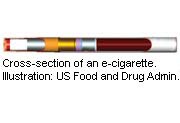
WEDNESDAY, Dec. 14 (HealthDay News) — A new report details exactly what kind of scientific proof the U.S. Food and Drug Administration should require from the makers of electronic cigarettes and tobacco lozenges to show that what they are selling is not harmful to the overall public health.
These “modified risk” products claim to offer individuals nicotine without the health risks, namely lung cancer and heart disease, that are associated with the use of traditional tobacco products such as cigarettes.
“These products are ones that might carry a claim that they have less risk to the user than a traditional tobacco product,” said Dr. Jane Henney, a professor of medicine and public health sciences at the University of Cincinnati and chairwoman of the Institute of Medicine (IOM) committee that wrote the report. “We believe that if those claims are to be approved by the FDA, the sponsor will have to bring to the agency a series of data to support that claim.”
These products are sold as part of a strategy to lower tobacco-related death and disease, especially among smokers who have had trouble quitting, but not much is known about the overall health risks of these products, according to the committee.
To determine that, the IOM report suggests that the FDA require testing in the laboratory and in animals, clinical trials with people, and post-marketing studies to see if any health problems show up once the products are in widespread use.
Given the “tobacco industry’s well-documented history of improper conduct,” the committee believes these studies should be done by independent third parties.
The authority for this kind of oversight was included in the 2009 Family Smoking Prevention and Tobacco Control Act, which requires that modified risk tobacco products undergo an approval process similar to drugs and medical devices.
Several groups applauded the IOM report’s recommendations.
“The American Lung Association commends the IOM for its recognition that if a tobacco product is allowed to be marketed as ‘safer’ that the product must actually be safer,” Charles Connor, president and CEO of the American Lung Association, said in statement.
“Decades ago, the tobacco industry developed light and low tobacco products that were no less harmful than those already on the market. Millions of Americans, who switched to those so-called ‘light’ and ‘low-tar’ products instead of quitting, died as a result of these claims. The scientific standards recommended by this expert panel are designed to prevent a repeat of similar attempts to deceive the American public. We encourage the FDA to heed these lessons and never lose sight of the deception and fraud perpetrated for decades by Big Tobacco,” Connor said in the statement.
“This report lays out a comprehensive scientific roadmap for the FDA to follow in reviewing applications for modified risk tobacco products,” Matthew Myers, president of the Campaign for Tobacco-Free Kids, said in a statement.
“It demonstrates the need for rigorous science, conducted and evaluated independent of the tobacco industry, before the industry is allowed to market any modified risk products,” he added. “It underscores the importance of the FDA considering the broad public health impact of introducing such products, and not just the impact on individual tobacco users. And it properly puts the burden on tobacco manufacturers to produce adequate scientific evidence before allowing them to claim that any tobacco product reduces the risk of disease.”
David Abrams, executive director of the Schroeder Institute for Tobacco Research and Policy Studies at the Legacy Foundation, said he believes the IOM report is right on target.
“These products are worthwhile, provided the overall public health message is adhered to,” he said. “It could cause, overall, long-term public health damage. For example, if it was more appealing to youth and young adults it might have a little less harm, but a lot more people would use it and that would violate the public health standard.”
According to the report, among the things studies should look at are whether the product is addictive and whether the components of the product are harmful to health. In addition, these products should be tested on current and former smokers, new smokers, adolescents and groups at high risk for tobacco use.
Tests also have to “evaluate whether this product would draw people to the use of this product who now don’t smoke, or who might have quit smoking and would be drawn back into this habit and therefore increase their risk,” Henney said. “These products should only be targeted to individuals who absolutely have been unable to stop smoking.”
The process should also be transparent, the report stated, with the companies and the FDA making all the data available to the public.
However, Ray Story, CEO of the Tobacco Vapor Electronic Cigarette Association, doesn’t see safety and public health as the driving factors behind the IOM recommendations, but thinks instead it is a conspiracy by tobacco companies, drug companies and the federal government to keep these products off the market.
“I’ve been fighting this issue for quite some time, but you are fighting much larger groups,” he said, noting that electronic cigarettes deliver nicotine without the risk of fire. “It does the same thing as a cigarette, without the 7,000 harmful chemicals and 65 carcinogens.”
More information
For more on quitting smoking, visit SmokeFree.gov.

